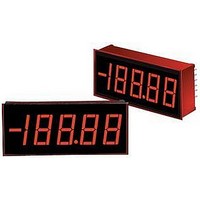DMS-40PC-3-RS-C Murata Power Solutions Inc, DMS-40PC-3-RS-C Datasheet - Page 5

DMS-40PC-3-RS-C
Manufacturer Part Number
DMS-40PC-3-RS-C
Description
DC Miniature Digital Voltage Meter
Manufacturer
Murata Power Solutions Inc
Datasheet
1.DMS-40PC-3-RS-C.pdf
(6 pages)
Specifications of DMS-40PC-3-RS-C
No. Of Digits / Alpha
4-1/2
Meter Function
DC Voltmeter
Meter Range
± 0V To ± 200V
Digit Height
13.2mm
Power Consumption
500mW
Operating Temperature Range
0°C To +50°C
Accuracy
±2
Display Type
4 - 1/2 Digit LED
Sample Rate
2.5 SPS
Rohs Compliant
Yes
Lead Free Status / RoHS Status
Lead free / RoHS Compliant
5. Engineering Scaling and Input Attenuation: In many applications,
6. BCD Outputs (DMS-40PC-X-RS and -RL-BCD Models Only):
APPLICATIONS
the input signal must be scaled, or divided down, before being applied
to the DMS-40PC. In some situations, the input signal exceeds the
full-scale range of the meter, and in other applications, a direct
one-to-one relation does not exist between the input voltage and
the desired display reading. For an example of the second situation,
assume an input voltage of 1.0Vdc is required to display a reading of
“7500” when applied to a ±2V input meter. An input divider circuit,
constructed with two series resistors with an output-to-input ratio of
0.75, will scale the 1.0V signal down to 0.75V.
Engineering scaling and input attenuation are discussed in Ap Note 4
of the DATEL Digital Panel Voltmeter Catalog. Compensating for inputs
which have a zero offset is also discussed.
Models with a “-BCD” suffi x have 12 extra output pins, labeled
A through L (6 per side), that provide the following information: mul-
tiplexed serial BCD data, digit drive, and polarity indication. The data
present on pins A - L simultaneously drives the meter’s internal LED
display. All functions on pins A - L are 5V CMOS compatible, however,
they are only rated to drive one, 74LS series, TTL load. CMOS logic
IC’s, for example 74HC or 74HCT series devices, should be used when
more fan-out capability is required.
As the timing diagram in Figure 5 indicates, 100Hz is the optimum
display scan rate when the BCD outputs are used to drive external
LED displays. Faster scan rates, while permissible, are not necessary.
Slower scanning, however, may result in noticeable “fl ickering” of
the display. Common anode LED’s, combined with a 74LS247 BCD
to seven-segment decoder, is the simplest way of implementing an
DIGIT DRIVE 1
DIGIT DRIVE 2
DIGIT DRIVE 3
DIGIT DRIVE 4
DIGIT DRIVE 5
STROBE OUT
BCD DATA
(4 LINES)
(MSD)
BUSY
(LSD)
Previous Conversion
Approx. 2msec
Data from
Approx. 5μsec
Approx. 2msec
www.murata-ps.com/dpm
Figure 6. BCD Data Timing Diagram
MSD
1
2
Approx. 8msec
3
4
The functions of pins A - L are listed below:
BCD DATA (pins I - L): Four lines are used for BCD (Binary Coded
Decimal) data outputs, representing the numbers 0 - 9. Positive-logic
convention (a high represents a “1”) is used.
DIGIT DRIVE ( pins A - E): These fi ve outputs, when gated with STROBE,
can be used to direct the BCD DATA into external latches. DIGIT DRIVE
outputs may also be connected directly to the bases of NPN transistors
in remote-display confi gurations. The digits are scanned right-to-left, i.e.,
MSD (DIGIT 1 DRIVE) to LSD (DIGIT 5 DRIVE).
BUSY (pin G): This is a status pin that goes high at the start of an ana-
log-to-digital (A/D) conversion cycle and remains high until the conver-
sion ends.
STROBE (pin H): A string of fi ve sequential, active-low, STROBE pulses
are output (after BUSY goes low) indicating the end of a conversion and
the availability of new data. The 5 STROBE pulses occur only once per
conversion, or 2.5 times each second. STROBE can be used to latch the
BCD data (on pins I - L) into external latches. Either edge can be used
since STROBE (~ 5μsec wide) is active only in the center of the cor-
responding DIGIT DRIVE and BCD DATA outputs.
POLARITY (pin F): This pin, which is also used inside the DMS-40PC to
drive the negative-sign segment, indicates whether the last input signal
conversion was positive (POLARITY set high) or negative (POLARITY set
low). POLARITY, unlike BCD DATA, is not multiplexed. For data latching
purposes, POLARITY should be sampled during the STROBE pulse for
digit 1 (most signifi cant digit).
external display. A seventy-fi ve to one-hundred Ohm resistor on each
LS247 segment-drive output provides adequate display brightness.
LSD
5
4½ Digit, LED Display Digital Panel Voltmeters
1
5 Strobes Only Per Conversion
2
3
DMS-40PC Series
4
04/05/11 MPM_DMS-40PC.C05 Page 5 of 6
5
email: sales@murata-ps.com











